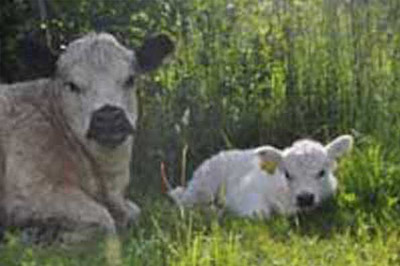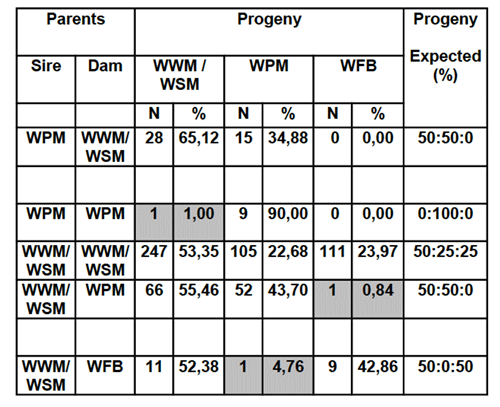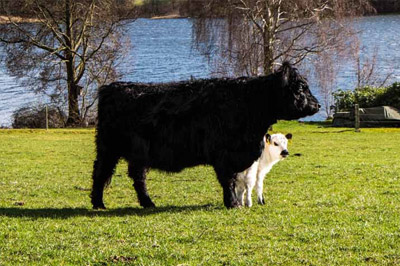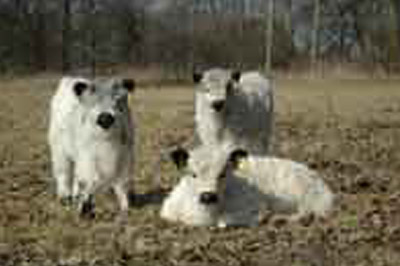The White Galloway Stars-Project
How pleasing it is to the eye to see these white cows out on their pasture, with perfect markings, their bodies white and only their ears, eyes and muzzles black. Ideally they should all also have four black “socks” on. A just as perfectly marked White Galloway bull joins the group and some nine months later, a few calves which are just as perfectly marked as their parents are born. Almost all breeders of White Galloways start out with such expectations. You don´t have to wait long for a big surprise: instead of white calves with perfect markings, we also get black calves, and strongly marked and poorly marked ones as well. What is the reason for it? This is a question that has long occupied the minds of White Galloway breeders. The wildest theories and speculation are widespread. Fortunately serious research scientists do not waste time on them. Prof. Swalve from the University of Halle and Prof. Brenig from the University of Göttingen are fascinated by this enigma of nature and want to try help solve it and so they have started a research project for this very purpose.
Mechthild Bening has posed this question to herself often during the some 20 years that she has been breeding White Galloways. Her extensive documentation as well as that of those breeders participating in the Project have provided a vast amount of material for the research work being carried out by Professor Swalve and Professor Brenig of the Georg-August-University’s Veterinary Institute in Göttingen, Germany which it is hoped will finally shed light in the darkness surrounding the inheritance of coat colour among Galloways.
Data recording sheets were developed which resemble a herd book registration sheet. Data recorded relates to the pedigree of an animal and to the coat colour and marking. Taken together, this data is the basis of the scientific investigations for the project White Galloway Stars. Welcome to the White Galloway Star Project.
Via www.whitegallowaystars.co.uk
Colour inheritance in White Galloways
Results from latest research points to a very specific mode of inheritance
by Prof. Dr. H.H. Swalve, University of Halle/Saale, Prof. Dr. B. Brenig, University of Göttingen and M. Bening, Bebensee (Schleswig-Holstein), Germany
1 Introduction
Within the cattle breed Galloway different colour lines exist which sometimes are recognized as different breeds. These are the colours Red, Black, and belted. White Galloways are somewhat rarer.

White Galloways are of a white to creamy colour and show black markings on muzzle, ears, and feet. There may be black spots at other parts of the body or markings, especially those of the feet are lacking or are over-pronounced. It is well known that matings of individuals with an ideal phenotype and perfect markings may result in offspring which deviate substantially from the desired phenotype or are even fully black. Hence, it would be desirable to know more about the exact mode of inheritance of the colours in White Galloways
2 Known facts about the inheritance of colour
The inheritance of coat colour in mammals is influenced by a number of genes. One well known gene is the MC1R-gene, also called “Red” gene which is responsible for the basic colours red or black. It is known that not all specific cases of colour inheritance can be reduced to the basic colours red and black. “Colour changers” and “roan” are two further variants of this gene. Other genes act as “colour diluters”, and again others play a role in the inheritance of spots and colour patterns. In horses, but also in cattle, the KIT gene has achieved a celebrity status since it has a proven effect on the expression of the colour white. Besides the conventional grey colour, in horses also colour variants exists which result in white spots or a complete “whitening” of darker colours and even a “dominant white” exists in horses, although limited to just a few breeds. For the spotted Holstein cattle breed it has been shown that the proportion of
white is, at least partly, influenced by the KIT gene. Furthermore, the environment, especially the prenatal environment can influence coat colour.
3 Basics of the project
Since 2010 we have conducted a scientific project which as a start consisted of collecting records on the colours and markings of White Galloways. At first, our work concentrated on collecting data from German breeders. We extended this to a more international scale by means of our web page www.whitegallowaystars.com. The focus of our data collection is on recording of an individual with its
coat colour and pedigree data.
The colour codes are the most crucial information on the data sheets. We have used
White, well marked (WWM) – A white animal with black markings on muzzle, ears and
feet – the perfect coat colour and pattern!
White, poorly marked (WPM) – An almost fully white animal, markings are missing,
White, strongly marked (WSM) – An animal with all the black markings of a “perfect” one, but also bearing some black colour in other places, sometimes even quite a bit of black
White, fully black (WFB) – This sounds like complete nonsense. It does mean: An animal born from a mating of two White Galloways, however, this animal is fully black
A WWM animal is the goal of White Galloway breeders:

In WPM animals (as in the calf on the right), the markings are lacking or are only slightly visible:

WSM animals have the desired markings, but additionally have further black spots, especially at the sides:

WFB denotes fully black animals which very simply could be black Galloways; however, the animal has White Galloway ancestors:

For the recording of animals in our database, WFB animals were of special importance since they would not qualify as White Galloways but yet occur now and then. It has to be noted that an exact differentiation between the colours and markings as given above is not always possible. Rather, the standards for the classification may have some overlap. In some cases, a WPM animal maybe identified by some person while another person would classify it as WWM. Other room for discussion are the borders between WWM and WSM, it is sometimes debatable what a “strongly marked” animal really is.
Anyhow, we consider the above classification as useful for most cases and were very happy to see that our database grew to 660 progeny with colour classification and known ancestors whose colours and markings were also known. Further data is flowing in continuously.
4 Examinations on the molecular level
In order to examine the genetic background of colours and markings of White Galloways, we have analysed four genes relevant to coat colour inheritance: Mast/Stem Cell Growth Factor Receptor (KIT), KIT-Ligand (stem cell factor), melanocortin 1 receptor, (MC1R) and tyrosinase (TYR). We were able to show that the colours of White Galloways and White Park cattle follow a mode of inheritance consisting of a duplication of the KIT gene originally located on bovine chromosome 6 and an insertion of this duplication on bovine chromosome 29. In animals and humans, this mode of inheritance is very rare, a relevant gene acting from two chromosomes at the same time! A similar case of colour inheritance has been reported for Belgian Blue Cattle (Durkin et al., 2012; Nature).
Fully black WFB animals have the wild-type chromosome 29 in the homozygous form (wt29/wt29). White Galloways and White Park being homozygous for the insertion and translocation (Cs29/Cs29) are almost white, WPM. WWM as well as WSM animals are heterozygous (Cs29/wt29). The colour of the markings is governed by the MC1R-gene, thus they can be black or red. Our results point to a dosage-dependent action of the KIT gene which acts “stronger” if additional copies of the KIT gene are found on chromosome 29.
The results have been published in a scientific journal under a peer-review procedure, i.e. every manuscript is evaluated for publication by independent experts. The manuscript (Brenig et al., 2013) was published in the journal Animal Genetics (44, 450–453) and is retrievable online under:
http://onlinelibrary.wiley.com/doi/10.1111/age.12029/abstract
5 Molecular examinations and the database: comparing results
Ultimately, the results from the molecular examinations mean that WWM and WSM animals cannot be differentiated at the gene level, at least not so far. Both types have a genotype for which the duplication of the KIT gene and its subsequent insertion on chromosome 29 has only happened once; the animals are thus heterozygous for the duplication and insertion. Almost fully white animals, WPM, hence are animals which are homozygous for the insertion and duplication. Finally, fully black animals, be they stemming from black Galloways or classified as WFB, simply are animals that do not possess the insertion and duplication. It has to be noted here that the terms ‘heterozygous’ and ‘homozygous’ which normally are used to denote genotypes made up from two alleles (‘variants’) of one gene on the paired chromosomes, here are used for the existence of the duplication/insertion.
Given the above, the following table (Table 1) presents the results from the database according to colour codes for parents and offspring. WWM and WSM codes are put together as one code.
Table 1: Colour codes of parents and the resulting offspring (n = 656 progeny)

The last column of Table 1 gives expected percentages for each type of mating based on the findings from the molecular analysis. The molecular analysis itself comprised 178 animals for which blood samples or DNA were available. The table demonstrates just three cases which would be denoted as impossible according to the molecular findings. These cases are shaded in grey. However, the three deviant cases just refer to three individuals. Hence, it can be assumed that these three cases pertain to errors in the recording. A further substantial deviance of expectations from observed values is found for matings of WPM x WWM/WSM (first result line in table): WWM/WSM progeny is observed for 65 % of all cases while the expectation is just 50 %. Again, taking into account that the coding was not perfect and especially considering the total number of cases in the first line (n = 43), random deviations may occur and may have contributed to this result. Also, it is rather obvious that collection of data took place in herds of registered White Galloways, thus WWM animals will have been a little bit over-represented. Summarizing the results, it is striking how molecular findings and the results from Table 1 are in agreement. Simple counts match the molecular work – it just has to be known how to count!
6 How to continue?
Galloway breeders have always sought to breed Galloway cattle that excel in type, muscling, and frame. For breeders of White Galloways it is furthermore important to breed animals that show the typical colour and markings. The results of the research project on the inheritance of colour in White Galloways should be taken as a further tool to achieve this goal. Up to now, almost white or black animals were hardly used in matings. Now, animals with good type and conformation can be used for planned matings even though they are only slightly marked or born with a black colour.
The next step is to put the research results into practice and has already been initiated. A sizeable number of breeders has been willing to participate in this and conducted planned matings in spring and summer 2013. Male and female animals of the colours WPM and WFB have been used for these matings. In the region of Schleswig-Holstein, the local cattle breeders association developed a specific breeding programme for this; the responsible officer of the breeder’s association has taken part in visually inspecting all respective animals. Based on the results of the project, we expect to receive calves which are well marked (WWM) or strongly marked (WSM).
7 Presentation of results
We expect to have calves from the planned matings on the ground in spring 2014. This will give a chance to everybody to see for themselves: Can the results from the scientific work be trusted?
The first calf “Nuance of Colour vom Bebensee” has been born already (Feb 24, 2014). The dam is WFB and the sire WPM. See, how it looks like:

A presentation of the results from the research project will be held in conjunction with the Galloway World Conference in Wildeshausen / Lower Saxony, Germany (Sep 2 to Sep 7, 2014). White Galloway breeders will also present their herds and the offspring from the planned matings.
This satellite conference will be hosted by the White Galloway breeders in Schleswig Holstein, the local cattle breeders association Rinderzucht Schleswig Holstein, and the scientists:
1. Presentation of results from the research project and inspection of the offspring of planned matings
When: September 8, 2014
Where: Schleswig-Holstein, Germany
Programm: Symposium with the scientists; presentation of offspring of planned matings with information on all ancestors; further visits to herds on request. Please check: www.whitegallowaystars.com
You can get further information from Mechthild Bening, email: [email protected]

Breeding Project Results
Probably need brief text in here about results to get people to know why they are clicking…
